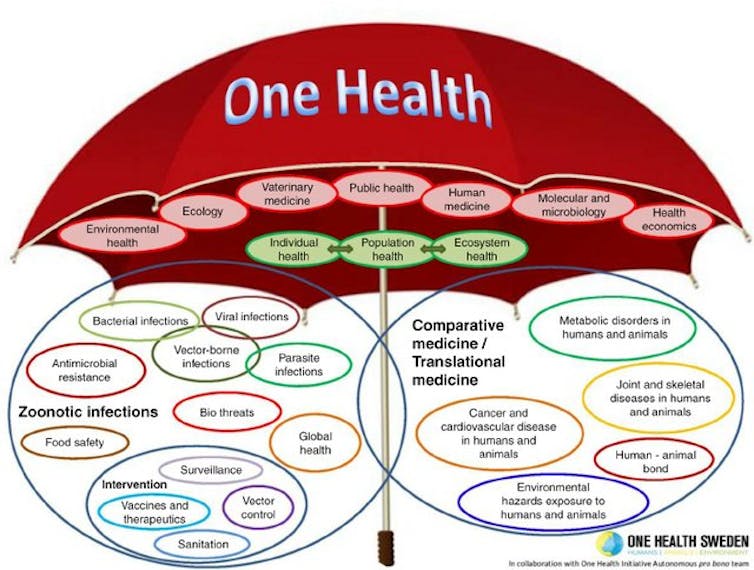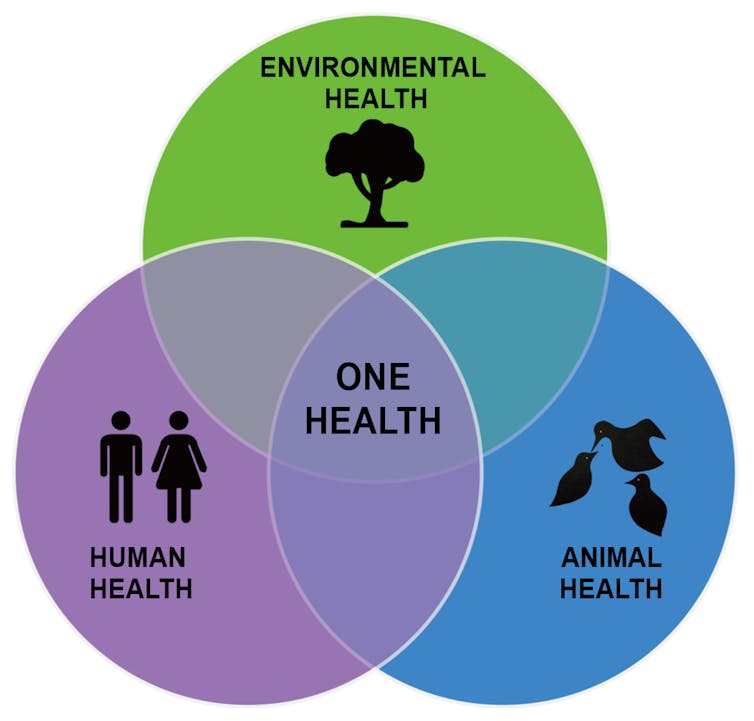It is both a concept, a strategy, and a goal. “One Health” has gradually established itself in the life sciences, veterinary medicine, and biomedical sciences. It now dominates the communication of international public health organisations such as the World Organization for Animal Health (OIE), the Food and Agriculture Organization (FAO), the World Health Organization (WHO) and the Centre for Disease Control and Prevention (CDC).
However, “One Health” remains little known to the public and is rarely integrated into government decision-making process. Representing a real paradigm shift, could help us better understand, anticipate, and manage the outbreak of new pandemics.
The obvious interconnection of living things
The term “one medicine” was introduced in 1984 by Calvin Schwabe. The American epidemiologist intended to underline the obvious interconnection between animal and human medicine. But he also pointed out the urgent need for collaboration between veterinarians and doctors to control the spread of infectious agents.
Of the 1,407 pathogens affecting humans, 58% are of animal origin, a quarter of which can be a possible transmission source for an epidemic or pandemic, like the influenza and Ebola viruses. In addition, 75% of emerging infectious diseases are of animal origin. A better understanding and management of animal reservoirs of infectious agents, but also their routes of transmission and adaptation to humans, is therefore essential for the control of zoonosis and future epidemics. Hence the growing interest in EcoHealth, an emerging discipline that cuts across ecology, epidemiology, and biomedical sciences.
It is disturbances in the dynamics of interactions between populations of humans, infectious agents, animal reservoirs, and sometimes insect vectors, which usually trigger epidemics of zoonotic origin. By varying their habitat or their abundance, environmental, climatic, and socio-economic changes can, for example, modify the probabilities of interactions between each population. Furthermore, infectious agents, and in particular RNA viruses, evolve very rapidly. They can therefore adapt to new hosts if they come into frequent contact with them, thus creating a new network of interactions.
Hunting, deforestation, climate… and epidemics
The link between human intrusion into an ecosystem and the onset of an epidemic is well illustrated by the case of the human immunodeficiency virus (HIV), which killed more than 32 million people between 1981 and 2018. Its emergence is probably due to an increase in hunting and consumption of chimpanzee meat in the Kinshasa region (Democratic Republic of the Congo) in the years 1920-50: the increased contact between humans and primates infected with the simian immunodeficiency viruses have promoted adaptation of this pathogen to humans.
Lyme disease can also be cited as an example. This pathology, which testifies to the links between alteration of biodiversity and epidemics, is due to a bacterium, Borrelia burgdorferi, transmitted by tick bites. In nature, ticks feed on many vertebrates. Some of these, such as squirrels and deer, are quite resistant to infection. Others, such as mice, are very susceptible to it. Because of the dilution effect, there are thus few infected ticks in forests with high biodiversity. But where it is low, in small wooded plots where predators are few, mice can see their numbers increase, which increases the frequency of tick infection and the risk for humans: in the Northeastern United States and Europe, a historic cycle of deforestation, reforestation and fragmentation of wooded areas has encouraged the progression of the disease.
The last example: global warming. It is now well established that it is a game changer for a wide range of vector-borne diseases in Europe and will continue to do so in the decades to come. We know, for example, that the tiger mosquito of Asian origin (Aedes albopictus), vector of diseases such as Zika, dengue and chikungunya, or the sand fly (phlebotominae), native to the Mediterranean basin and North Africa and which transmits leishmaniasis, have now established themselves in southern Europe.
Management dependent on the societal context
To best manage an epidemic, it is important to consider the socio-economic, political, religious, and cultural realities of the country concerned. The support of populations for public health strategies is also essential. In short, communication and education strategies must adapt to each societal context.
Take the case of brucellosis. This disease is caused by Brucella bacteria, several species of which chronically infect domestic ruminants. Humans can be infected through direct contact with affected animals or, more often, through consumption of contaminated food, but transmission between humans is almost nonexistent. Acting on the animal reservoir thus reduces the economic costs associated with the loss of livestock and improves human health.
In Europe, brucellosis has been virtually eradicated by vaccination and systematic killing of infected herds. This approach, however, has only been made possible by harmonizing the health policies of different countries – including the identification of domestic animals, their testing and control of their movements – and compensation for breeders. However, this cannot be applied to developing countries, where both economic resources and the operational capacities of veterinary services are limited. Take the case of India, where brucellosis remains endemic. The lack of financial compensation for farmers and the religious killing ban on cattle make it impossible to test and dispose infected animals. Therefore, in India, only a strategy based on vaccination is viable.
A multidimensional and multidisciplinary approach
The “12 Manhattan Principles” were presented in 2004 in New York (USA) at a conference organized by the Wildlife Conservation Society.
The first of these principles stresses the need to recognise the links between human health, animal health and the environment. It also points out the need for holistic and prospective approaches to emerging infectious diseases considering the complex interconnections between species. Or, that of a reduction in trade of wild animals because of “the real threat it poses to global socio-economic security”; increased investment in health infrastructure and infectious disease surveillance networks; quick and clear sharing of information; education and sensitisation of populations and political decision-makers to the interconnection of living things.
The conclusion delivered in the congress summary is critical:
“Solving the threats of today and the problems of tomorrow cannot be accomplished with the approaches of yesterday… We must design adaptive, forward-looking and multidisciplinary solutions to the challenges that undoubtedly await us.”

The “One Health” concept was introduced in 2008 in Sharm el-Sheikh (Egypt), during a symposium on the risks of infection linked to contact between human and animal ecosystems.
Shortly afterwards, following the H1N1 influenza A pandemic of 2008-2009, WHO adopted a global influenza program involving increased surveillance of animal reservoirs. At the same time, the first One Health agency was created in the United States. It is now working to promote a global health security agenda, in cooperation with many other national and international organisations, and involves around 60 countries.

Since the emergence of “One Health”, other similar concepts have emerged, such as EcoHealth and Planetary Health. Taking into account the interconnection of living things, but also the necessary abandonment of any linear and reductive thinking, and having in common a decompartmentalization of disciplines, these new concepts should make it possible to better understand and manage health crisis.
The importance of anticipating
We all live in the same world, and both our health and our economy are closely linked to its condition. If we want to achieve the United Nations Millennium Development Goals, it is imperative to consider the multiple interactions between public health, economy, animal health and the environment. However, as the chaotic management of the Covid-19 pandemic has highlighted, the “One Health” vision is rarely adopted by policy makers.
While the emergence of new viral pandemics of zoonotic origin has been repeatedly predicted by the scientific community, governments have been unable to anticipate. Worse, they have put in place diverse (and sometimes contradictory) national measures, while a pandemic is clearly a global problem requiring concerted international action.
Of course, we must learn from this. In the “One Health” vision, the pandemic induced by SARS-CoV-2 is the direct and predictable consequence of the globalisation of animal production systems, the sale of live wild animals, but also of mass tourism, international trade and the hypermobility that accompanies them. And notwithstanding what some may imply, it cannot be interpreted as a black swan, an unexpected event that has a cause external to our liberal economic system.
This article was translated in collaboration with the Volunteer Translation Team of the Federation of European Microbiological Societies (FEMS).
ABOUT THE AUTHORS
Eric Muraille, Biologiste, Immunologiste. Maître de recherches au FNRS, Université Libre de Bruxelles (ULB) and Jacques Godfroid, Professor of Microbiology, University of Tromsø
This article is courtesy of The Conversation.
"allow" - Google News
October 20, 2020 at 11:22AM
https://ift.tt/3jd47Fx
The 'One Health' Concept Must Prevail to Allow Us to Prevent Pandemics - Global Biodefense
"allow" - Google News
https://ift.tt/2KTEV8j
https://ift.tt/2Wp5bNh
Bagikan Berita Ini















0 Response to "The 'One Health' Concept Must Prevail to Allow Us to Prevent Pandemics - Global Biodefense"
Post a Comment